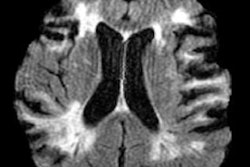
CT is a safe alternative to invasive coronary angiography (ICA) for diagnosing coronary artery disease (CAD). The study was simultaneously published on March 4 in the New England Journal of Medicine and presented at ECR 2022 Overture.
 Prof. Dr. Marc Dewey.
Prof. Dr. Marc Dewey.The results could lead to better patient outcomes by reducing patient exposure to the small but real risks of invasive angiography, according to a team led by Prof. Dr. Marc Dewey of Charité University Hospital in Berlin. Dewey is the European Society of Radiology's (ESR) research chair and incoming ESR publications chair, as well as the editor of Cardiac CT.
"CT has generated interest [for this indication] since it may rule out obstructive CAD in a noninvasive procedure with a low risk of adverse events as it identifies patients who are appropriate candidates for coronary revascularization," the group noted.
Although invasive coronary angiography with cardiac catheterization has long been the reference standard for diagnosis of obstructive CAD -- and allows for coronary revascularization during the procedure -- it does carry some risk.
"As an invasive examination, cardiac catheterization is associated with rare but serious complications [and] about half of all cardiac catheter examinations in Europe and the U.S. do not result in a CAD finding that requires treatment," the group wrote in a brief about the research.
Dewey's team sought to investigate the efficacy of CT compared to cardiac catheterization for diagnosing CAD using data from the DISCHARGE (Diagnostic Imaging Strategies for Patients with Stable Chest Pain and Intermediate Risk of Coronary Artery Disease) trial, which began in 2014 and is funded by the European Commission and the Berlin Institute of Health and German Research Foundation.
The investigators compared CT and invasive coronary angiography as diagnostic imaging strategies for 3,667 patients with stable chest pain and intermediate pretest probability of obstructive CAD; the patients were initially referred for ICA at one of 26 European centers.
The primary study outcome was major adverse cardiovascular events such as cardiac arrest, nonfatal heart attack, or nonfatal stroke over 3.5 years after CAD diagnosis; secondary outcomes were complications related to procedures and angina pectoris.
Dewey and colleagues found that the risk of major adverse cardiac events was similar between the two modalities, but the incidence of procedure-related complications was four times lower with CT compared with ICA.
| Incidence of post-CAD diagnosis major adverse cardiac events by modality in patients with stable chest pain | ||
| Events | ICA | CT |
| Incidence of major adverse cardiovascular events among patient cohort | 3% | 2.1% |
| Procedure-related complications | 1.9% | 0.5% |
| Angina | 7.5% | 8.8% |
The study supports findings from two other trials, the Prospective Multicenter Imaging Study for Evaluation of Chest Pain (PROMISE) and the Scottish Computed Tomography of the Heart (SCOT-HEART) study, the team wrote.
"Our trial confirmed the safety of a CT-first strategy and showed results that were similar to those with ICA," Dewey and colleagues reported. "CT identifies covert CAD, which may be of greatest value in patients with atypical symptoms."
The research suggests that using CT instead of ICA could improve outcomes by reducing patient exposure to the risk of angiography complications, wrote Dr. Joseph Loscalzo, PhD, of Brigham and Women's Hospital in Boston in an accompanying editorial.
"Among 52% of patients with abnormal results on functional testing, only approximately half were found to have obstructive CAD on subsequent angiography," he wrote. "These results suggest that alternate diagnostic strategies need to be considered to identify obstructive lesions of functional importance."



















